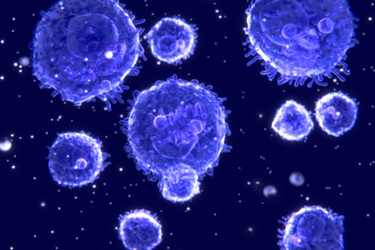Gamida Cell On Improving Natural Killer Cell Therapies

By Tyler Menichiello, Chief Editor, Bioprocess Online

Earlier this year, the FDA approved Gamida Cell’s allogeneic cell therapy, Omisirge (omidubicel-onlv), to aid neutrophil recovery in patients with blood cancer. This therapy was developed with Gamida’s nicotinamide (NAM) technology, which is also being used to develop the company’s natural killer (NK) cell therapy candidate, GDA-201. NAM appears to improve NK cell functionality and metabolic fitness. To learn more about the potential for NAM technology to improve NK cell therapy products, I spoke to Gamida Cell CEO, Abigail Jenkins, and CMO/CSO, Dr. Ronit Simantov.
The following responses have been edited for clarity and length.
What are the current challenges in the NK cell space that Gamida Cell is working to address with NAM and GDA-201?
 Simantov: NK cells come with a lot of promise. One advantage of NK cells is they don’t need to be human leukocytic antigen (HLA) matched to patients. In terms of attacking cancer, NK cells don’t engage the same level of immune recognition as T cells, so the idea of using NK cells as a cancer therapy was quite promising. However, it was found that NK cells lose a lot of their potency in culture (i.e., they lose their ability to kill cancer cells). So, attempts to use NK cells as therapies have been disappointing in the past.
Simantov: NK cells come with a lot of promise. One advantage of NK cells is they don’t need to be human leukocytic antigen (HLA) matched to patients. In terms of attacking cancer, NK cells don’t engage the same level of immune recognition as T cells, so the idea of using NK cells as a cancer therapy was quite promising. However, it was found that NK cells lose a lot of their potency in culture (i.e., they lose their ability to kill cancer cells). So, attempts to use NK cells as therapies have been disappointing in the past.
We were able to adapt our NAM technology to NK cells. What we’ve done is developed an NK cell that can overcome some of these challenges — specifically, resistance to oxidative stress, resistance to loss of metabolic fitness, and maintenance of an immature phenotype that continues to kill even after adoptive transfer of the cells. NAM technology makes NK cells more powerful and more potent, so we are excited about studying these cells in patients to characterize their effect on tumors. We’re currently studying GDA-201 in patients with non-Hodgkin lymphoma in a Phase 1 dose-escalation study. Our preliminary data has shown that not only did the NK cells directly attack lymphoma cells, but they also recruited T cells and elements of the adaptive immune system to help fight tumors. Our hypothesis about the potential of these NK cells is not only will they improve direct killing and antibody-dependent cytotoxicity in tumors, but that they can also engage the immune system to continue the attack against tumors to become a real, potent therapeutic.
What are the advantages of sourcing NK cells from donors?
Simantov: We believe that stem cells sourced from adult donors have heterogeneity we can take advantage of in terms of NK functionality. These cells also have enough plasticity to maintain metabolic fitness and an active phenotype. NK cells — or any cells that are circulating in an adult donor — are all going to be at different points in their development. They were created and have been circulating for different amounts of time, and with those time intervals, they change in phenotype. They express different markers at different time periods during their development, and there’s a functional purpose to each of those phenotypes. So, we can take advantage of this reality by bringing all these cells into our culture and enhancing them with NAM without having to create each of the markers on the NK cells ourselves. It’s really taking the best parts of their biology and using them as a potential treatment for patients.
How did you make the decision to bring cell manufacturing in-house?
 Jenkins: It served Gamida Cell well to have an outside partner as we went through clinical development. It’s an expensive investment, so if you can get a good partner to work with you through clinical development, it can be a good choice. However, when it comes to commercialization, you really need to know that you can deliver the product. Sometimes, the best way to know that you’re going to be able to deliver the product is if you have that capability in-house where you can fully control your supply chain. Under the previous CEO’s leadership, the team made the decision to bring that capability in-house, and I think it’s one of the smartest decisions Gamida Cell made. We have that capability. We have control over the supply chain where once we receive the cells, it’s up to us to deliver them back to the patient. If a company can make that investment, I would strongly encourage them to consider bringing manufacturing in-house. We have to fulfill our commitments to our patients, and certainly the best way to have confidence in doing so is to have manufacturing as part of our in-house team.
Jenkins: It served Gamida Cell well to have an outside partner as we went through clinical development. It’s an expensive investment, so if you can get a good partner to work with you through clinical development, it can be a good choice. However, when it comes to commercialization, you really need to know that you can deliver the product. Sometimes, the best way to know that you’re going to be able to deliver the product is if you have that capability in-house where you can fully control your supply chain. Under the previous CEO’s leadership, the team made the decision to bring that capability in-house, and I think it’s one of the smartest decisions Gamida Cell made. We have that capability. We have control over the supply chain where once we receive the cells, it’s up to us to deliver them back to the patient. If a company can make that investment, I would strongly encourage them to consider bringing manufacturing in-house. We have to fulfill our commitments to our patients, and certainly the best way to have confidence in doing so is to have manufacturing as part of our in-house team.
What do you think are the biggest barriers to bringing the costs down of these therapies in the coming years, and how successful do you think the industry will be?
Simantov: The cost of developing drugs, no matter the therapy, is high. It’s costly to conduct clinical trials to monitor patients, monitor the data, and submit the data. Certainly, as technology evolves and improves, costs will come down because of efficiencies that will be created. That is an area where I know there are efforts to address these issues, and hopefully, collaborations between regulators, physicians, and industry experts can help manage and reduce those costs.
Jenkins: I think that standardization and the potential for automation are two promising areas. Standardization comes when there are more and more cell and gene therapy companies going through the regulatory process and, ultimately, reaching drug approval. Gamida Cell is in the select minority of cell therapies that have made it all the way to a commercial stage. As more cell therapies become commercialized, I think we could see maybe 10 or 20 years from now there being some technology that enables us to be more consistent across the industry. Right now, each company is really pioneering. Perhaps in the future, there will be some best practices, and that might create an opportunity for supply chain partners to offer more automated technology. Right now, it’s a manual process. There’s not going to be a near-term solution, but I think there’s the hope there could be more cost-efficiencies built into the process as we move forward. With these donor-derived cells, it’s possible to grow many more cells at a time and serve many more patients at once. This will ultimately make allogeneic cell therapies and NK cell therapies more scalable and commercialized.
